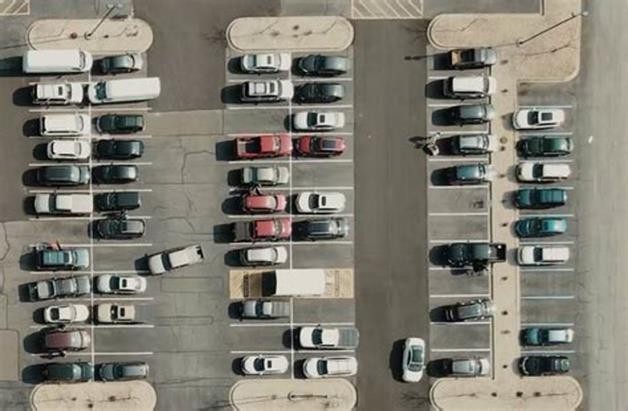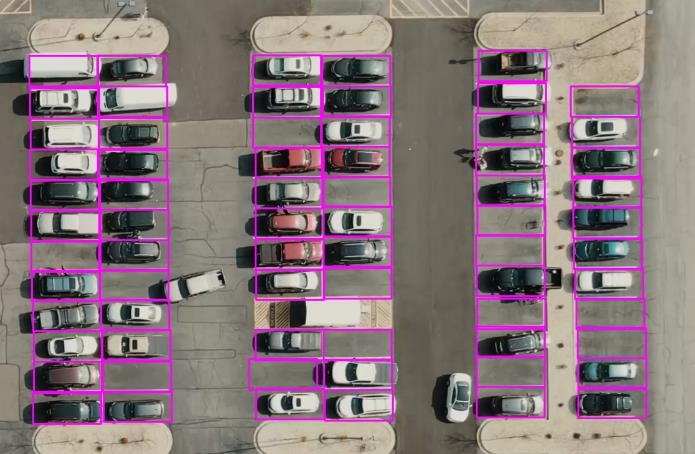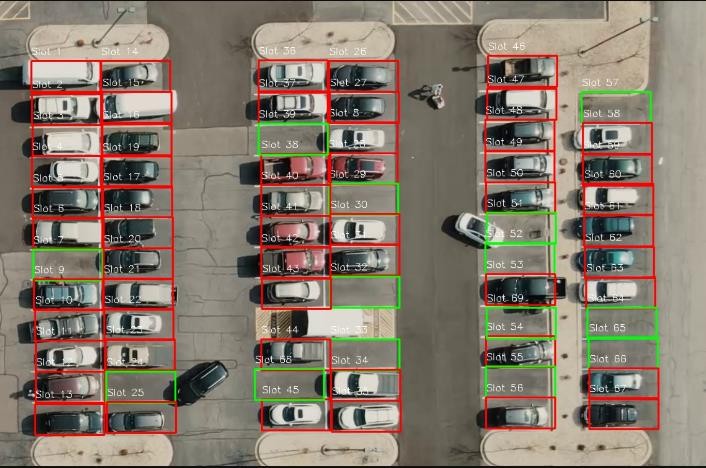Ijraset Journal For Research in Applied Science and Engineering Technology
- Home / Ijraset
- On This Page
- Abstract
- Introduction
- Conclusion
- References
- Copyright
Parking Slot Vacancy Detection Using Machine Learning
Authors: Srushti M J, Ravindra S, Spoorthi K S, T S Chandana, Indu Priya Shirisha
DOI Link: https://doi.org/10.22214/ijraset.2024.66006
Certificate: View Certificate
Abstract
Parking congestion is a persistent issue in urban environments, leading to wasted time, fuel, and environmental impact. This paper introduces a \'Parking Slot Vacancy Detection System\' that leverages real-time video feeds and machine learning algorithms, specifically Mask- RCNN, to accurately detect vacant and occupied parking slots. Predefined slot mapping, vehicle detection, and real- time processing are combined to provide efficient and scalable solutions. The proposed system minimizes errors caused by lighting variations or overlapping objects, aiming to enhance parking lot utilization and reduce driver frustration.
Introduction
I. INTRODUCTION
Urban parking inefficiencies result in drivers spending significant time searching for vacant spaces, contributing to congestion and pollution. Traditional parking systems, including manual monitoring and sensor-based solutions, often fail to scale with growing demands and diverse parking conditions.This research focuses on developing a machine learning-based system to detect parking slot vacancies. The primary goals include automating the detection process for reduced manual intervention, ensuring high accuracy and real-time processing, and enhancing parking management through efficient space utilization. The study covers the use of Mask-RCNN for vehicle detection, the integration of predefined parking slot mapping, and real-time feedback systems.
II. LITERATURE SURVEY
In this section, various authors have presented various Machine Learning techniques.
In [1] Parking space detection is performed using computer vision techniques and ultrasonic sensors integrated into a real- time parking management system. The system employs strategically placed sensors and OpenCV-based image processing algorithms to analyze parking lot occupancy. A user-friendly interface provides real-time data on parking availability through web or mobile applications, enhancing the efficiency of parking management.
In [2] This research outlines a vision-based approach to detect parking space occupancy using camera input processed through image segmentation and deep learning. The system captures video streams, extracts frames, and employs the DNN algorithm for parking space analysis. The study reviews various methodologies, including sensor-based and vision- based techniques, highlighting the limitations of current solutions. The proposed system is cost-effective, with real- time implementation capabilities, and supports mobile and web-based access for remote monitoring and parking space reservation.
In [3] The paper "Real-Time Car Parking System Using Image Processing" by Sayanti Banerjee, Pallavi Choudekar, and M.K. Muju proposes an intelligent car parking management system leveraging image processing techniques to address urban parking challenges. The system uses a camera to capture real-time images of vehicles, processes these images through RGB to gray conversion, gamma correction, and edge detection (using the Prewitt operator), and then matches them with a reference image. This approach identifies parked vehicles and available slots efficiently. The hardware includes a USB web camera and a PC for processing, while MATLAB is used for software functionalities. The system provides real-time parking guidance, optimizing parking space utilization and simplifying driver navigation.
In [4] The paper "Detection of Parking Slots Based on Mask R-CNN" by Shaokang Jiang, Haobin Jiang, Shidian Ma, and Zhongxu Jiang introduces a robust method for parking slot detection using Mask R-CNN, incorporating ResNet101 and feature pyramid networks for superior image feature extraction. The proposed system accurately identifies parking slots in various conditions, including vertical, parallel, and slanted slots, achieving a precision of 94.5% and recall of 92.7%. The system leverages the Line Segment Detection (LSD) algorithm to refine results and can function under complex illumination and dynamic environments, marking a significant advancement in autonomous parking systems.
In [5] This paper presents a system that leverages image processing techniques to automate parking management, in aiming to address urban congestion issues and optimize parking space utilization. The proposed methodology includes modules for system initialization, image acquisition, segmentation, enhancement, and detection. Techniques like HSV thresholding, SIFT, and FLANN are applied to identify parking boundaries and vehicle presence. The system is tested with images from an 8MP camera, demonstrating accurate detection of vacant spaces. Potential future improvements include incorporating GPS, mobile booking, and centralized management systems.
In [6] paper "A Method of Parking Space Detection Based on Image Segmentation" proposes a novel algorithm containing image segmentation features to detect parking space occupancy. The Mean Shift algorithm is used for adaptive segmentation, achieving accurate results in various parking lot conditions. Texture features are integrated to enhance detection reliability, especially in challenging scenarios like similar vehicle and ground colors. Tested on indoor and outdoor parking lots, the method achieves a detection rate of over 97%. Limitations include difficulty in detecting non- vehicle objects and occluded spaces, suggesting future work to incorporate video feeds and tracking for better occlusion handling.
In [7] this paper presents a smart parking system utilizing a preprocessed Mask R-CNN model and mAlexNet for parking space detection. The system introduces preprocessing steps like contrast enhancement using the Exposure Fusion framework to address lighting variations in outdoor parking areas. The Mask R-CNN detects parking spaces by marking Regions of Interest (ROI), and mAlexNet classifies each ROI as either occupied or vacant. Testing on CCTV video data under varied lighting conditions achieved an Intersection over Union (IoU) accuracy of 85.80% for detection and 73.73% for classification. Despite these results, the system's effectiveness can be impacted by environmental challenges such as reflections and occlusions.
In [8] This paper introduces a real-time smart parking system that combines image processing and machine learning to detect and count vacant parking spaces. The system utilizes a camera network to capture parking lot images, processes them with image enhancement and segmentation techniques, and classifies each space as empty or occupied using machine learning. Real-time parking availability is displayed via electronic signage or mobile apps. The system provides benefits such as enhanced parking efficiency, reduced traffic congestion, and integration potential with other smart city systems, although challenges remain in adapting to varied environmental conditions.
|
Authors |
Title |
Research focus |
Remarks |
|
Anant Sharma |
PARKING Space Counter Using OpenCV |
Developed a real-time parking space management system using ultrasonic sensors and computer vision techniques integrated with OpenCV. |
Achieved accurate detection of parking availability but faced challenges with varying environmental conditions. |
|
Purva Hattale and Vikrant Jangam |
Parking Space Detection Using Image Processing |
Vision-based parking occupancy detection using live-stream cameras and DNN algorithms. |
Provides a cost-effective solution with browser/mobile access. Performance is affected by environmental factors and camera placement. |
|
Ms. Sayanti Banerjee, Ms. Pallavi Choudekar, and Prof. M.K. Muju |
"Real-Time Car Parking System Using Image Processing" |
Intelligent car parking management using image processing. |
Proposes a real-time parking management system using image processing techniques such as edge detection and image matching. |
|
Shaokang Jiang, Haobin Jiang, Shidian Ma, and Zhongxu Jiang [5], 2020 |
"Detection of Parking Slots Based on Mask R-CNN" |
Deep learning-based parking slot detection |
Proposes a method utilizing Mask R-CNN with ResNet101 and FPN, achieving high precision and recall under varying illumination and slot orientations. |
|
Ashu Yadav and Kirti Bhatia |
Car Parking Space Detection Using Image Processing |
Automated parking management using image processing techniques like HSV thresholding, SIFT, and FLANN. |
Accurately detects parking vacancies using an 8MP camera. Recommends future integration with GPS and mobile apps for booking. |
|
Wang Lixia and Jiang Dalin |
A Method of Parking Space Detection Based on Image Segmentation. |
E Developed a parking detection algorithm using Mean Shift segmentation to identify occupied spaces. |
Achieved a detection rate above 97%, but struggled with occlusion and similar color interference. |
|
Ahmad Afif Naufal et |
Preprocessed Mask R-CNN for Parking Space Detection in Smart Parking Systems |
Developed a smart parking system combining preprocessed Mask R-CNN for parking space detection and classification. |
Achieved robust results under varied lighting but faced challenges with environmental factors. |
|
Abhishek Kumar and Kavita Agrawal |
Parking Space Finder Using Image Processing and Machine Learning |
Proposed a real-time system combining image processing and machine learning for parking space detection and occupancy monitoring. |
Enhanced parking efficiency and reduced congestion but faced adaptation issues in varied conditions. |
III. IMPLEMENTATION
The proposed system utilizes advanced computer vision techniques to deliver an efficient, real-time parking management solution, combining automated monitoring with user-friendly interaction. By processing a video feed simulating a live parking lot, the system identifies the occupancy status of predefined parking spaces frame by frame. It begins with grayscale conversion to simplify the data and reduce computational overhead. This is followed by Gaussian blurring to minimize noise, ensuring reliable thresholding. Adaptive Gaussian thresholding is applied to segment the image into binary regions, distinguishing occupied slots from free ones. Additional steps like median blurring and morphological dilation refine the image to enhance detection accuracy by filling gaps and smoothing contours.
The system initializes parking slots as predefined rectangular regions, with their coordinates stored in a serialized file (CarParkPos). These slots are loaded during runtime and represent fixed areas in the parking lot. This static setup simplifies implementation but assumes that the parking layout does not change dynamically.
For monitoring, each slot region is cropped from the processed frame, and non-zero pixel counts are computed to evaluate occupancy. A threshold value is used to classify slots as free or occupied. Free slots are visually marked with green rectangles, while occupied ones are shown with red. Additional overlays display slot numbers and pixel counts, improving transparency and making the system user-friendly.
Beyond basic monitoring, the system integrates advanced features to enhance functionality. Users can interact with the interface via mouse clicks to book or unbook parking slots. During booking, vehicle details, such as license plate numbers, can be entered and associated with a specific slot. Moreover, the system tracks the duration a vehicle occupies a slot and calculates parking charges dynamically based on a predefined hourly rate. These features ensure that the system is not only visually intuitive but also operationally practical for parking lot management.
The system also addresses video frame overflow by resetting the feed to the first frame when the last frame is reached. This mechanism ensures continuous operation, making it suitable for prolonged or repeated usage, such as in public parking lots or demonstrations. By combining robust image processing with interactive functionality, the proposed system presents a scalable and practical solution for smart parking management. It provides real-time insights into parking lot availability, facilitates user interaction for booking and payments, and offers a foundation for further enhancements, such as dynamic slot detection or integration with license plate recognition systems.
IV. RESULT

Fig 4.1: Original Picture
Fig 4.1 shows an aerial view of a parking lot showing multiple rows of parked vehicles

Fig 4.2: Slot marking
Fig 4.2 shows marked parking slots using Mask-RCNN (Mask Region-based Convolution Neural Network)

Fig 4.3: Vacant Slot Detection
Fig 4.3 shows Detected available or vacant parking slot
Conclusion
The Parking Slot Vacancy Detection System demonstrates the potential of machine learning to address urban parking challenges. By providing real-time, accurate updates on slot availability, the system enhances driver experience, optimizes parking lot utilization, and contributes to environmental sustainability. Future developments could focus on predictive analytics and expanding the system\'s applicability to dynamic parking environments.
References
[1] Anant Sharma, Harshmeet Singh Maan, and Mr. Rohit Maheshwari, \"Parking Space Counter Using OpenCV,\" Career Point International Journal of Research (CPIJR), Vol. 4, Issue 2, December 2023. OpenCV-based image processing methods analyze occupancy, while a user-friendly interface provides real-time data for users. pp. 98-108. [2] Purva Hattale, Vikrant Jangam, Shrutika Khilare, Yash Ratnaparkhi, and Pradnya Kasture, “Parking Space Detection Using Image Processing,” International Journal of Science and Research (IJSR), Vol. 10, Issue 3, 2021, pp. 1440-1442. [3] Ms. Sayanti Banerjee, Ms. Pallavi Choudekar, and Prof. [4] M.K. Muju, “Real-Time Car Parking System Using Image Processing” from Ajay Kumar Garg Engineering College, Department of Electrical, Electronics, and Mechanical Engineering, Ghaziabad, UP, India, 2011 IEEE. [5] Cong-Cuong Le, P.W.C. Prasad, Abeer Alsadoon, L. Pham, and A. Elchouemi, “Text Classification: Naive Bayes Classifier with Sentiment Lexicon” published in the IAENG International Journal of Computer Science IAENG International journal of computer science 46:2, IJCS_46_2_01 ,2019 PP:1-8. [6] Ashu Yadav and Kirti Bhatia, “Car Parking Space Detection Using Image Processing,” International Journal of Advance Research, Ideas and Innovations in Technology, Vol. 7, Issue 4, 2021, pp. 1698-1701. [7] Lixia Wang and Dalin Jiang, \"A Method of Parking Space Detection Based on Image Segmentation and LBP,\" from the College of Electronic Information Engineering, Beijing University of Technology, published in 2012 Fourth International Conference on Multimedia Information Networking and Security, IEEE, 2012, pp. 225-232. [8] Ahmad Afif Naufal, Chastine Fatichah, and Nanik Suciati, \"Preprocessed Mask R-CNN for Parking Space Detection in Smart Parking Systems,\" from the Department of Informatics Engineering, Institute Technology Sepuluh Nopember, published in International Journal of Intelligent Engineering and Systems, 2020, pp. 255-262. [9] Abhishek Kumar and Kavita Agrawal, \"Parking Space Finder Using Image Processing and Machine Learning,\" from the Department of Computer Science and Engineering, Integral University Lucknow, published in International Journal for Multidisciplinary Research (IJFMR), Volume 5, Issue 4, July-August 2023, E-ISSN: 2582-2160, pp. 1-13.
Copyright
Copyright © 2024 Srushti M J, Ravindra S, Spoorthi K S, T S Chandana, Indu Priya Shirisha. This is an open access article distributed under the Creative Commons Attribution License, which permits unrestricted use, distribution, and reproduction in any medium, provided the original work is properly cited.

Download Paper
Paper Id : IJRASET66006
Publish Date : 2024-12-18
ISSN : 2321-9653
Publisher Name : IJRASET
DOI Link : Click Here
 Submit Paper Online
Submit Paper Online

